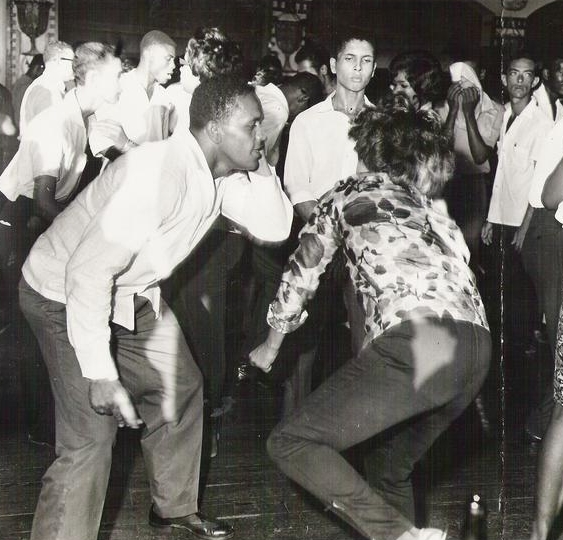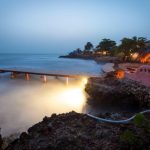
Jamaica’s street dance culture dates back to the late 50’s early 60’s. In anticipation of Jamaica gaining independence from Britain, the late 50’s brought about a new found spirit of nationalism. Inspired by this, local jazz musician and pioneering producer “Coxsone” Dodd was driven to create a uniquely Jamaican dance sound. This music was called Ska and fused American jazz and R&B with Jamaican mento, and featured a strong bass and drum rhythm section, guitars, keyboards and brass. Rocksteady, and later, reggae eventually evolved from ska in the late 1960’s.
In response to ska, a dance called “the ska” was created and then later the more popular “skanking”, these were Jamaica’s first urban dance moves. “Ronnie and Jeanette” a popular local dance team visited the 1964 World’s Fair in New York along with renowned Jamaican musicians in order to demonstrate the phenomenal music and dance innovations.
By the late 60’s early 70’s, “Teenage Dance Party” a popular weekly radio program which showcased the most popular North American music along with the emergence of reggae, made the regular creation of new dance moves essential. These urban dance moves were to become a vital component in defining Jamaican dancehall culture. The innovative dancers in every community prided themselves as being pacesetters by how successful they were in creating and spreading their moves through parties or “dances.” These dancers would eventually form dance troupes, troupes such as Blacker Spades, GQ, and LTD added the element of theatrics and acrobatic moves to popular moves and took their act to the stage. By performing at talent shows, school barbeques, high school parties and entering dance competitions, these troupes would expose the greater public to the amazing dance culture emerging from the ghettos in Kingston. In addition, to the many stage shows showcasing the skills of the talented dancers, television also played a major part. In 1971, a young cameraman for the local TV station JBC (Jamaica Broadcasting Corporation, now TVJ) named Alphonso Walker created a program aimed at young people. This TV show had two segments one which was geared to promoting and showcasing local talent in a party like atmosphere (not unlike Soul Train) and the other a forum where issues affecting young people in the society were discussed. The Show was called Where It’s At, and would take Jamaican urban culture into almost every Jamaican home. Eventually the show was overhauled, according to Alphonso ‘the show did not have the right type of energy, it was too bland”. He decided then to take out the forum, and replace the “uptown” dancers with dancers from the inner city, which included members of the Funky Phonics who he thought was more energetic and creative. He was right, the result was a more potent show, and appealed to a greater audience. The show lasted for 15 years. People would tune in weekly to find out what the new dance was, as a result the Where It’s At dancers became very popular, and you could see their influence on the dance floors of Jamaica. The mid to late 70’s brought a wave of R&B and funk music to dance floors, dancers would now need a new repertoire of dance moves to respond to this music. Their affiliation with JBC allowed the Where It’s At dancers access to satellite transmissions of U.S TV programs, one program of particular interest to them was Soul Train. Soul Train gave the dancers an inside track to what was going on in urban dance in America and allowed them to be up to date on the new music and dances that went with them.
As the 80’s rolled around, The music video generation began to emerge; a brew of new wave, punk, rap, reggae, funk and R&B music began to get played with equal importance at parties and on the radio due to the influence of American television. With the advent of the satellite dish, more people now had access to the music videos on MTV and BET, the great demand for all the new music coming out of America and Europe, was answered by local radio and the sound systems which played the music at parties. For the first time in years, not knowing what the “new move” was was not a big deal. Dancing to new wave or punk didn’t require any special knowledge, you just moved any which way to the beat.
In the 60’s and 70’s, Jamaicans seeking better economic opportunities and a less volatile atmosphere made the decision to migrate to America and England, the children of these expatriates would return as visitors in the eighties when the economy and safety improved, they brought with them the new trends in American urban culture. It is through this avenue that Jamaicans got introduced to the new craze called “Break Dancing” (I will use the term as the media did to encompass both the NY and LA. street dance cultures) that was sweeping America, Canada and England. It is ironic that Hip hop culture was born partially as a result of the migration of DJ Kool Herc who shared the Jamaican sound system culture with New York audiences, this eventually resulted in him innovating the “breakbeat” concept.
It was a Canadian cousin of one of the Where It’s At dancers who first demonstrated “Popping” to the public at a weekly party called “Teen Jam” in the summer of ’82. This introduction however was not unique, at the same time other Jamaican youngsters were also being inspired by the new dance as visitors to North America, or by their American relatives. Popmaster Ice, Jamaica’s premier popper recalls his cousin showing him how to glide/moonwalk and the ideas behind popping and waving. “It was like someone landing from outer space” he says. At the same time videos like “Save the overtime for me” by Gladys Knight, “All night Long” by Lionel Richie and Malcolm McLaren’s Buffalo Gals, brought the New York City Breakers, Rock Steady Crew, Popping Taco, Boogaloo Shrimp and Shabba Doo into the Jamaican home, and so the Bboy culture of New York and the Popping/Locking culture of Los Angeles took Jamaica by storm. This onslaught drastically changed Jamaican urban dance culture as it had existed before, the reggae and funk dances were almost totally replaced by the more dynamic popping and breaking moves, the teen parties that were usually held in nightclubs moved almost exclusively to larger school auditoriums where Bboys and Poppers could battle and display their skills without restriction. The Bboys and Poppers who were in their mid-to late teens soon formed crews ousting the dance troupes of the funk/rockers era who had gone before and were now in their twenties. These crews now became the focus of attention for the frequent stage shows and public performances. Crews such as Devils, Pop Culture, Volcanic Cobras, Mod Squad, G-Force, Aliens, and Magnetic Kiss (which had the dancehall artist, Mad Cobra as a member) dazzled audiences with the incredible moves which seemed to defy gravity and deceive the eye.
The “Break Dance” era lasted about 5 years, after which a lot of the major dancers had reached the age when they had to make serious life decisions about their future, many migrated to the U.S., Canada, and England seeking better opportunities, or to attend college, others entered the work force or got involved with other aspects of entertainment. Unfortunately for Jamaica and the rest of the world, “Break Dance” succumbed to over-commercialization, viewing it as a passing fad younger dancers chose to abandon the culture. The U.S. club dances and reggae dancehall moves reemerged in the late 80’s, parties moved from school auditoriums back into nightclubs, or outdoor venues, however apart from the small handful of reggae dance troupes who performed with dancehall entertainers and mainly emphasized theatrics and comedy in their dance routines, it seemed the concept of the dance troupe or crew regularly performing for the general public was becoming extinct. Instead solo dancers like Bogle and Bruk Up recycled moves from the “funk” and “popping” eras and put them to a reggae dancehall beat. Soon their reputation as ‘dance move makers’ pushed them to the forefront of Jamaican dancehall culture. With the explosion of dancehall culture in the early 90’s, these two dancers would be the ones to take Jamaican urban dance culture to the world.
Poll







